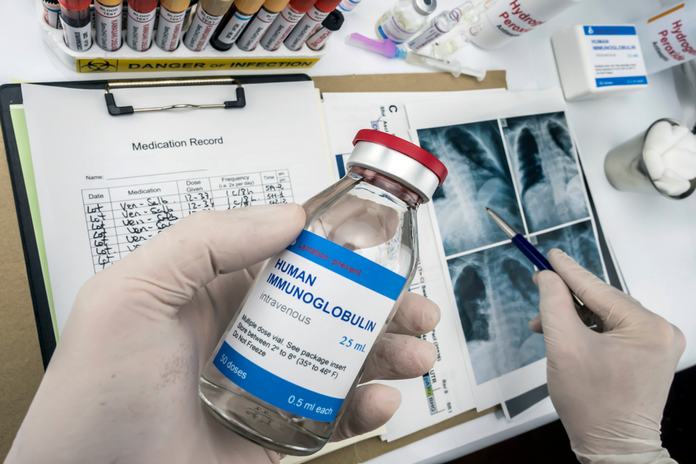Why IVIGs for Kawasaki Disease?

Are you struggling to figure out the differences between immunoglobulins that are used to treat Kawasaki disease? You’re not alone. There are several differences and some are subtle, so it’s easy to get confused.
You probably know the most important part of any Kawasaki Disease treatment is medication, but the importance of immunoglobulins shouldn’t be overlooked. Approximately 50% of patients will develop moderate or severe dehydration and electrolyte imbalances. This can become a serious issue, as in larger quantities electrolytes keep your heart beating efficiently and fluid in your blood vessels can help avoid brain swelling.
Kawasaki disease treatment aims to prevent coronary artery aneurysms and other cardiac complications. IVIG and aspirin are the mainstays of treatment for Kawasaki disease. Patients with Kawasaki disease should be admitted to the hospital for echocardiography, aspirin and IVIG administration, and close medical observation until their fever subsides.
Treatment with IVIG reduces the rate of CAAs from approximately 25% in untreated patients to 3-5% in treated patients, which reduces acute inflammation. IVIG administration is most effective when given within 7-10 days after the onset of fever. It is often given between days 5-7, but there is some controversy as to when IVIG should be started.
Studies have shown that single high doses of IVIG are more effective than IVIG given as a lower dose (400 mg/kg/day) over 4 days. Currently, the dose is 2 g/kg intravenously over 10-12 hours.
Approximately 10-15% of patients do not respond to IVIG. A fever that occurs 36 hours or more after IVIG is considered treatment failure. A second treatment with IV immunoglobulins at the original dose is often recommended in these cases. A second dose of IVIG may not be effective for some patients, but most show clear signs of recovery and the fever has settled.
A study of ethnically diverse patients in San Diego, California, found that patients with IVIG resistance tend to have lower platelet counts and age-adjusted hemoglobin concentrations and higher percent bands, CRP, gamma-glutamyl transferase, and alanine aminotransferase. CAAs were also more common among them. An IVIG resistance score system has not been found to be clinically useful due to insufficient accuracy.
Another study reported that initial treatment with IVIG (2 g/kg) did not result in a response for 13% of patients. In two patients with IVIG-resistant Kawasaki disease, the diagnosis was delayed, resulting in the development of giant aneurysms. High ESR was associated with an increased risk of IVIG-resistant Kawasaki disease. At the acute phase and a month after onset, patients with IVIG-resistant Kawasaki disease had a higher prevalence of coronary artery lesions. According to the AAPRD (American Academy of Pediatrics Red Book), live vaccinations are contraindicated for 11 months following the administration of IVIG for Kawasaki disease.
What is the purpose of aspirin in Kawasaki disease?
The treatment of Kawasaki disease has long included aspirin. In fact, it does not impact the development of CAAs, causing its use to be questioned. Most experts use medium-to-high-dose aspirin for a variable period followed by low-dose aspirin, despite some authors suggesting that aspirin is no longer necessary.
For its anti-inflammatory effects, medium to high doses (30-50 mg/kg/day) of aspirin divided four times daily are usually given during the acute phase. In general, this is continued until the patient has been afebrile for 48-72 hours or until the 14th day of the illness.
Low-dose aspirin is often initiated once the patient has remained afebrile for 48-72 hours. As long as the child does not show signs of coronary abnormalities, the dose is 3-5 mg/kg/day for 6-8 weeks. Aneurysms are usually treated with aspirin either until they are resolved or indefinitely.
Results of randomized controlled trials are insufficient to determine whether aspirin should continue to be administered to children with this disorder. There have been no clinical studies or randomized controlled trials of adequate quality and there is insufficient clinical as well as practical evidence to refute or support the use of aspirin in children with Kawasaki disease as part of their treatment regimen, according to a study.
Aspirin users should receive annual influenza vaccinations and varicella vaccinations if they remain on long-term, low-dose aspirin. Furthermore, the possibility of developing Reye syndrome during an active infection with influenza or varicella needs to be addressed. In patients suffering from influenza or varicella, Clopidogrel (Plavix) can be substituted for aspirin for a short period of time. Patients who are allergic to aspirin can also use this drug. Concomitant use of ibuprofen during aspirin therapy is contraindicated, as it antagonizes the irreversible effect of aspirin on platelets.
If warfarin or heparin is required, the pediatrician or cardiologist who provides the long-term care should monitor the aspirin therapy
